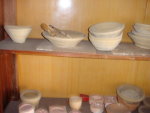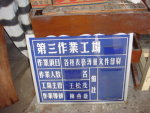Department of Operations
Foreword

(The ceramics)
(picture source:photo by this team)
Department of Operations is responsible for managing work conditions within the factories, and for instructing the skills training for inmates. In recent years, the education of inmates has received more attention. In order to teach inmates the habit of labor and to learn a skill, there are courses on advertisement design, architectural drawing, furniture repair, sewing, baking, and cooking; in addition, there are courses that teach about traditional industrial arts that are in danger of disappearing. Work distribution is based on personal skills, length of sentences, and interest; inmates are also audited. The purpose of work is to train their hearts and minds, so that they are active and not bored and brooding. They can also learn skills that allow them to get their lives back on track after they return to society.
Comparison between Old Prison and New Prison at Chiayi
Types of operations Old Prison:
There are 4 processing fa ctories – the printing factory, bamboo factory, woodwork factory, and machinery factory. Each factory can accommodate about 80 workers.
- New Prison:
There are 12 processing factories and 4 types of self-operated work categories: plastic flower factory, face mask factory, tea factory, incense paper money factory, ballpoint pen factory, toothpick factory, static-resistant cloth factory, oven factory, clothing factory, sun visor factory, gift box factory, and handbag factory. Each factory can have about 150 workers.
- Products manufactured

(The ceramics)
(picture source:photo by this team)
The Old Prison rarely sells things outside of the prison, and tend to only be purchased by the personnel.
The new prison conducts its transactions according to the locations designated by the government, accepting orders from institutions, organizations, or individuals to make or process items. For example, items can be sold at the storefront section or at some farmer and fisher markets. Labor fees encourage the inmates, who also gain a sense of accomplishment, prison personnel bonuses, and living subsidies. Inmates can use such fees to purchase living necessities, and can even alleviate the pressures on their families.
This clay item was made by an inmate; it is intricate and culturally representative clay work of art; this helps inmates adjust and become used to hard work.
Auditing items for the inmates

(Work plank)
(picture source:photo by this team)
These are divided into work, cultivation, and behavior; these are respectively scored by the work teacher, training teacher, and supervisor. The maximum score was 4, and the score of 4 is reserved for exceeding work quotas. For example, if one had to make 500 items per day, and the inmate makes 800, he would have 4 points. Conversely, 1 is the minimum point, and inmates who do far less than the work quota receive only 1 point; for example, if one had to make 500 items per day, and the inmate only makes 100, he only receives 1 point.
Source:
-
Researched and organized by this team
-
Interviews with Ms. Chiu
-
Department of Operations
